Often seen as symbols of danger, wolves in the Bible also offer unexpected lessons in transformation and redemption—discover their deeper significance.

What Does the Wolf Symbolize in the Bible
While you might associate wolves primarily with stories of wilderness and survival, their symbolism in the Bible offers a deeper, more complex narrative. Often depicted as predators, wolves carry connotations of destruction and greed, but also embody themes of transformation and redemption that are less frequently discussed.
They're used metaphorically to represent false prophets, warning believers of the dangers lurking in sheep's clothing. However, the biblical portrayal of wolves doesn't end with cautionary tales. As you explore further, you'll uncover layers of meaning that challenge the one-dimensional view, revealing lessons in vigilance and the potential for change.
Why not join the conversation and uncover the multifaceted roles wolves play in biblical texts?
Key Takeaways
- Wolves symbolize spiritual dangers like false prophets and greed in the Bible.
- Biblical narratives use wolves to represent the need for inner change and repentance.
- Achieving harmony with wolves suggests spiritual renewal and peace.
- Wolves metaphorically underscore the importance of vigilance and transformation in spiritual journeys.
The Wolf as a Predator
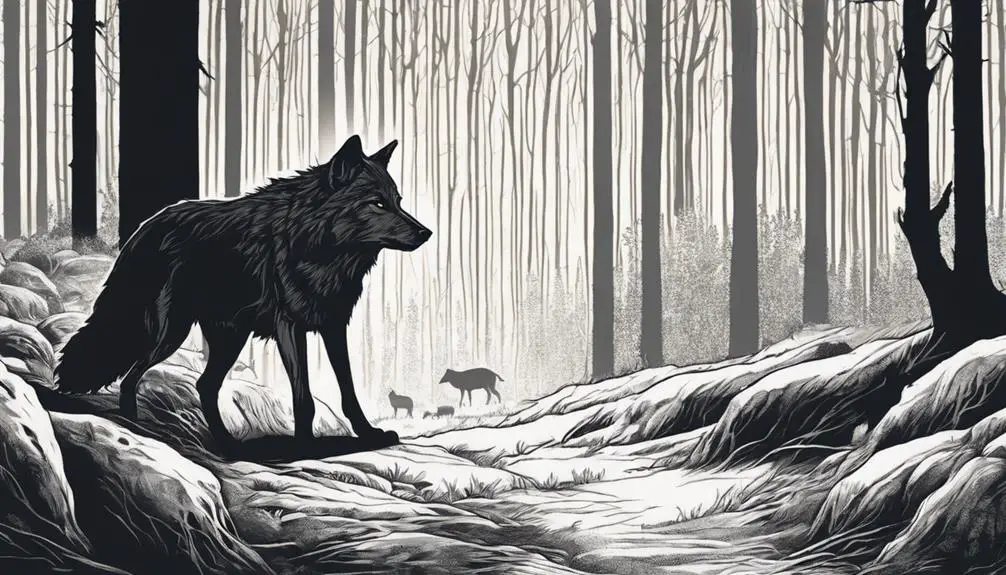
In the Biblical context, the wolf frequently emerges as a symbol of predation, embodying threats and challenges that believers may face in their spiritual journey. This imagery leverages wolf characteristics and hunting tactics to convey a rich tapestry of warnings and lessons. You can't help but notice the precision with which the Bible uses the wolf's nature to mirror the adversities you might encounter.
Wolves are known for their cunning and strategic hunting tactics. They operate in packs, embodying a sense of unity and purpose that, when reflected upon, can serve as a cautionary parallel to the way challenges and temptations often don't come at you in isolation. You're reminded that just as wolves hunt with patience and strategy, the dangers to your faith often manifest through persistent, coordinated threats.
Moreover, the wolf's adaptability in various environments underscores the unpredictable nature of the spiritual challenges you might face. Just as a wolf can thrive in different terrains, from forests to tundras, the tests to your faith aren't confined to a single aspect of life but can emerge from unexpected quarters. This adaptability prompts you to remain vigilant and adaptable in your spiritual journey.
The solitary aspect of the wolf, when it breaks from the pack to hunt or explore, further symbolizes the personal nature of some spiritual challenges. You're reminded that while some tests are communal and require collective faith and action, others are deeply personal, requiring you to confront them with individual resilience and faith.
Analyzing the wolf as a predator in the Biblical narrative, therefore, not only enlightens you about the nature of spiritual adversities but also equips you with the insight to navigate them with wisdom and fortitude.
Symbol of Destruction
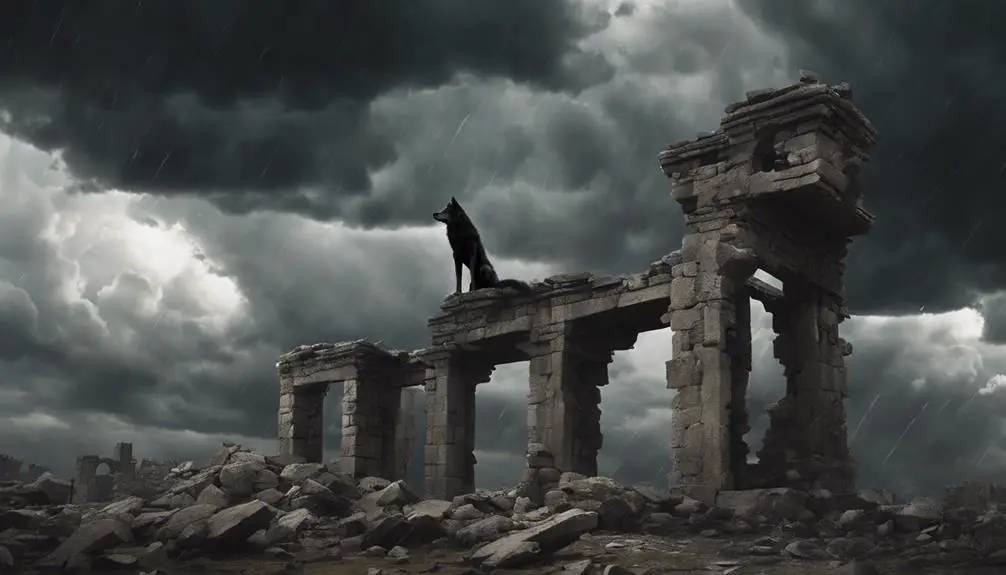
The wolf's representation extends into a powerful symbol of destruction, highlighting the profound impact that spiritual decay can have on an individual's faith journey. In the biblical context, this imagery serves as a cautionary tale, urging believers to stay vigilant against the forces that threaten to undermine their spiritual foundation.
The pack mentality of wolves mirrors the way destructive ideologies can spread within communities, leading to societal chaos. This analogy is particularly resonant in scripture, where the collective behavior of wolves is often used to illustrate the dangers of straying from the path of righteousness.
Consider the deeper meaning of the wolf as a symbol of destruction:
- Pack Mentality: Like wolves, negative influences often work in groups, magnifying their potential for harm and spreading discord among the faithful.
- Societal Chaos: The disruptive power of wolves in nature parallels the upheaval that moral and spiritual decay can wreak on society.
- Spiritual Vulnerability: Just as a wolf preys on the weakest members of the flock, spiritual decay targets our most vulnerable points, exploiting them to lead us astray.
- Isolation from the Pack: The lone wolf is a reminder of the consequences of separating oneself from the community and the protective guidance it offers.
- Warning Against Complacency: The presence of wolves signals the need for constant vigilance in safeguarding one's faith against the forces of destruction.
Representation of False Prophets
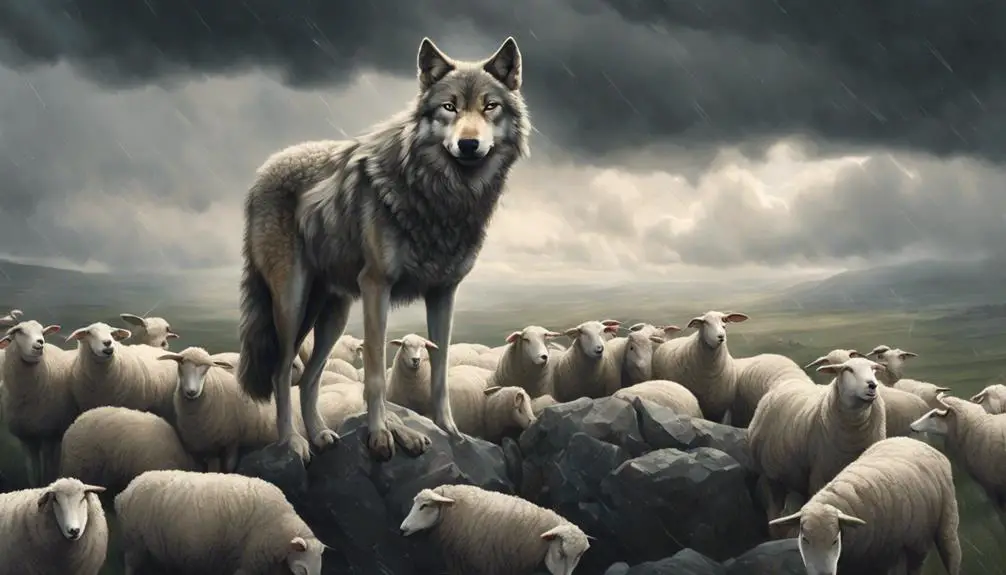
Shifting focus to another crucial aspect, wolves also symbolize false prophets who, with their deceptive teachings, pose a serious threat to the integrity of one's spiritual journey. This representation is profound, as it not only signals the danger posed by these individuals but also highlights the subtlety with which they operate. The metaphor of wolves in sheep's clothing is particularly poignant, encapsulating the essence of their deception. You might find them wrapped in the guise of light, professing truth while their hearts harbor darkness.
The Bible's prophetic warning about false prophets isn't just a cautionary tale; it's a directive for vigilance. It implores you to look beyond the surface, to discern the spirit behind the words spoken. This imagery of wolves, then, isn't arbitrary but a carefully chosen symbol that resonates with the natural cunning and predatory nature of wolves. Their ability to blend in, to mimic the very creatures they seek to devour, is a stark reminder of the false prophets' modus operandi.
Moreover, this biblical metaphor serves as a tool for self-reflection. It challenges you to examine the voices you choose to follow, urging you to seek authenticity and truth. The representation of wolves as false prophets underscores the importance of spiritual discernment. It's a call to be wary, to test every spirit, and not to be swayed by appearances.
In essence, the symbolism of wolves in this context is a multifaceted one, encompassing the themes of deception, discernment, and the perennial struggle between truth and falsehood.
Emblems of Greed

Wolves, beyond their representation as false prophets, also emerge as potent emblems of greed, reflecting a deep-seated warning against the dangers of insatiable desire. In the Bible, these creatures aren't just symbols of spiritual or moral failings but also serve as powerful economic metaphors, highlighting the pernicious effects of greed on both individuals and societies. The scriptural references to wolves, in this context, draw a vivid picture of social inequality and the exploitation that often accompanies unchecked desire for wealth and power.
To understand the full depth of the wolf's symbolism in economic terms, consider the following points:
- Wolves are depicted as never satisfied, always hunting for more, mirroring the endless pursuit of wealth that can lead to personal moral bankruptcy and societal harm.
- Their predatory nature underscores the exploitative practices that widen the gap of social inequality, preying on the vulnerable and exacerbating divisions within communities.
- Scripture uses the image of the wolf to caution against the idolatry of wealth, suggesting that such greed can distance one from spiritual and communal harmony.
- The comparison of certain individuals to wolves warns of the deceitful nature of those consumed by greed, who may appear trustworthy but harbor selfish motives.
- Finally, the biblical portrayal of wolves as emblems of greed serves as a reminder of the importance of vigilance and ethical conduct in economic dealings, advocating for a balance between prosperity and generosity.
Transformation and Redemption
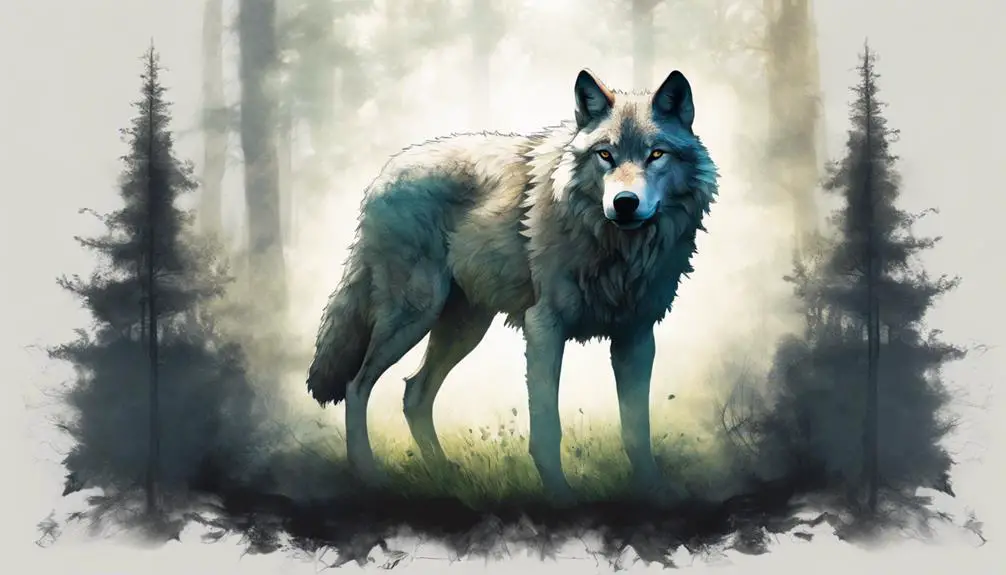
ARTICLE TITLE: Symbolism of the Wolf in the Bible
PREVIOUS SUBTOPIC: 'Emblems of Greed'
CURRENT SUBTOPIC: 'Transformation and Redemption'
While exploring the wolf's role as a symbol of greed unveils aspects of economic exploitation and social injustice, it also paves the way for understanding its representation in themes of transformation and redemption within biblical narratives. This dual symbolism suggests that even those who've wandered far off the path, embodying the wolf's predatory nature, can undergo profound inner change, leading to spiritual renewal.
The biblical narrative often juxtaposes the wolf's viciousness with the possibility of redemption, offering a powerful metaphor for human transgressions and the transformative grace of forgiveness. It's a reminder that through faith and repentance, individuals can transition from a state of spiritual wilderness to one of harmony and peace, much like the wolf transforming from a symbol of threat to one of restoration.
To make this concept more relatable, consider the following table illustrating the journey from greed to redemption:
Symbolic Element |
Represents |
|---|---|
Wolf's Predatory Nature |
Human transgressions and greed |
Transformation |
The process of inner change and repentance |
Sheep in Harmony with Wolves |
Achieved spiritual renewal and peace |
Biblical Narratives |
Framework for understanding redemption |
Faith and Repentance |
Pathways to transformation |
This analysis underscores the depth of the wolf's symbolism in the Bible, moving beyond its initial representation of greed to embody the profound potential for transformation and redemption within the human spirit.
Lessons in Vigilance
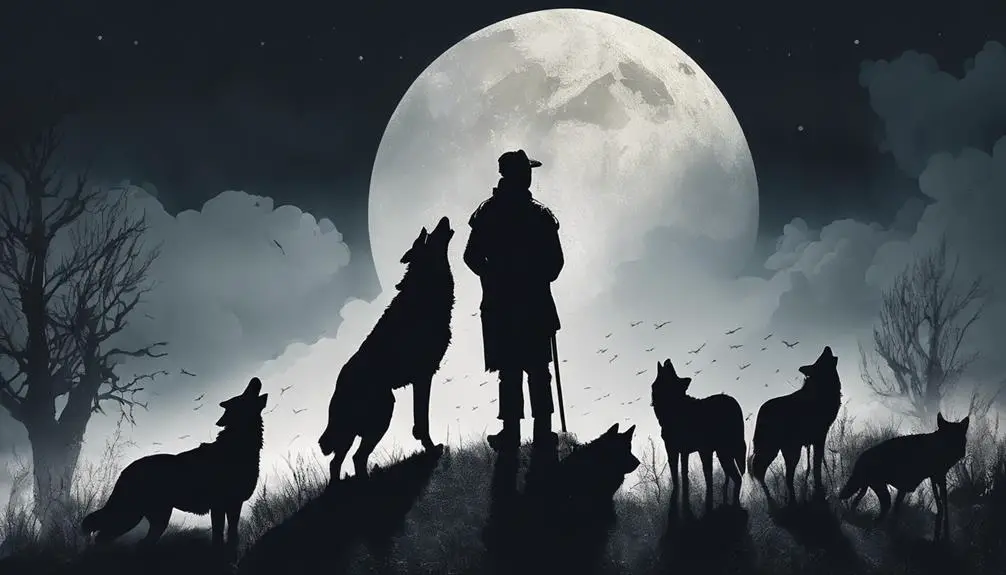
Beyond the themes of transformation and redemption, the wolf in biblical narratives also serves as a potent emblem for the importance of vigilance in spiritual life. This imagery compellingly illustrates the necessity for constant watchfulness against spiritual threats and challenges. The wolf's presence in these stories isn't just a cautionary tale but a directive to maintain a state of alertness.
The role of the shepherd, who must protect their flock from wolves, especially during the night watches, underscores this message. The shepherd's duty to guard, watch, and sometimes fight against these predators symbolizes a broader spiritual responsibility. It's a vivid reminder that, just as the shepherd remains vigilant to protect their sheep, you're tasked with safeguarding your spiritual well-being from potential dangers.
To further explore this concept, consider the following points:
- The importance of discernment: Understand the subtleties of spiritual dangers that can sometimes masquerade as benign or even beneficial.
- The value of community: Just as a shepherd watches over a collective, your spiritual journey benefits from the support and vigilance of a community.
- The necessity of proactive measures: Anticipate potential threats rather than simply reacting to them.
- The role of faith: Trust in a higher power can guide and strengthen your vigilance.
- The commitment to daily vigilance: Spiritual threats don't adhere to a schedule; constant awareness is crucial.
In essence, the biblical portrayal of wolves not only symbolizes potential spiritual threats but also highlights the critical nature of vigilance in your spiritual life. Through discernment, community, proactive measures, faith, and daily commitment, you can navigate these challenges effectively.
Frequently Asked Questions
How Does the Cultural Context of Biblical Times Influence the Perception of Wolves in the Scriptures?
In biblical times, cultural perceptions heavily influenced how animals, like wolves, were viewed. These perceptions, steeped in the context of their era, shaped animal metaphors used in scriptures.
You'll find that wolves, often seen as threats to livestock and symbols of danger, were metaphorically linked to negative attributes. This cultural backdrop offers a deeper understanding of their symbolic significance, providing insight into the ancient world's complex relationship with nature and morality.
Are There Any Positive Depictions of Wolves in the Bible, Outside of Transformation and Redemption Themes?
You're diving into whether the Bible presents wolves in a positive light beyond stories of transformation and redemption. It's intriguing, but truthfully, positive depictions are scarce.
The scriptures frequently use wolf parables and shepherding imagery to symbolize danger and moral lessons, rather than to cast wolves in a favorable light. This approach underscores the cultural and theological views of the time, emphasizing caution and vigilance in spiritual and community life.
How Do Different Translations of the Bible Potentially Alter the Symbolism and Interpretation of Wolves?
Navigating different Bible translations is like threading through a tapestry of time, where each thread colors the wolf in varying hues. Translation consistency and linguistic evolution play pivotal roles in this process. They're the dual lenses through which you discern the wolf's symbolism, shedding light on how interpretations shift with language's fluidity.
This analytical journey reveals the profound impact that word choice and cultural context have on understanding biblical imagery, offering a scholarly insight into ancient texts.
In What Way Do Wolves in the Bible Reflect the Relationship Between Humans and Nature as Understood in Ancient Times?
In ancient times, wolves in biblical texts mirror the complex dynamics between humans and the natural world. Through animal metaphors and nature personification, these narratives dissect humanity's respect, fear, and understanding of nature's power.
You'll find that these stories offer deep insights into how ancient societies navigated their relationship with the wild, emphasizing the delicate balance and often adversarial relationship between human civilization and the untamed aspects of the natural world.
How Has the Symbolic Meaning of Wolves in the Bible Influenced Modern Christian Art and Literature?
In the tapestry of modern Christian art and literature, wolf imagery serves as a thread weaving through centuries of tradition. This symbol, rich in biblical heritage, has shaped artistic interpretations, casting wolves as both menacing adversaries and redeemed creatures.
You'll find these nuanced depictions reflect a deep, scholarly analysis, echoing ancient understandings yet speaking profoundly to contemporary audiences. They encapsulate a transformative journey, mirroring spiritual redemption and the complexities of human nature.
Conclusion
In your journey through biblical symbolism, you've seen how the wolf, much like a shadow that looms at twilight, embodies a complex tapestry of meanings.
It's not just a predator; it's a symbol of destruction, a representation of false prophets, an emblem of greed, yet also a beacon of transformation and redemption.
This duality urges you to remain vigilant. The wolf teaches us that within the darkness, there lies the potential for enlightenment, challenging us to look beyond the surface.



Sign up